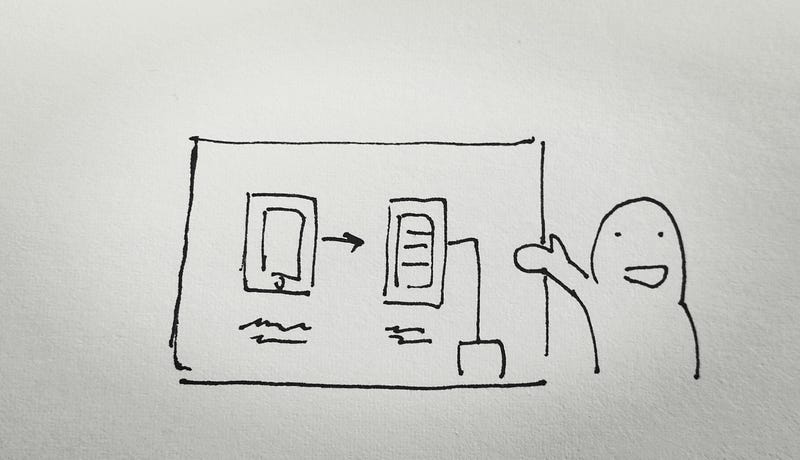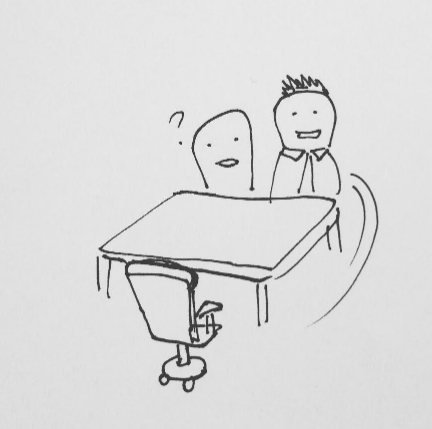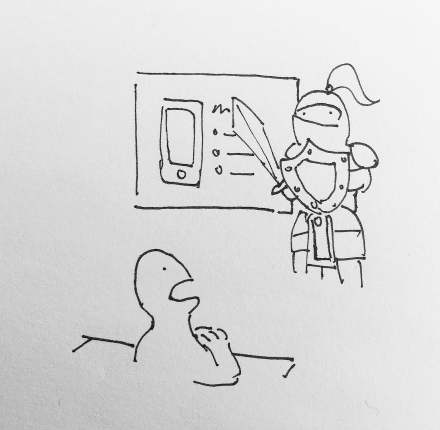Insights from a designer that became an interviewer.

Last week, I interviewed someone for the first time. It was for a junior UX designer position and for all my professional careers, I have been in the interviewee’s seat. Being in the opposite end of the table has been an eye opening experience for me, and I have learned few things that I wouldn’t have otherwise.
In this article, I want to share some insights I learnt that would help you interview better for an UX position, so here it goes.
Insight #1 — Your interviewer is on your side.

Look, I might have a Senior in my title, but I am just a designer that is looking for another designer to help me with my job. As an interviewer, I am not here to test you or throw you a challenge. I am actually on your side. Why? Because…
Company hires to solve a pain.
When a company decides to hire someone, they are in pain. They are at a point where they either A) Figured out putting the designers on over time just wouldn’t produce the same kind of work Bob did before he left 3 months ago or B) Needed to do something but they don ’t have the knowledge or time to do it themselves.
Hiring people costs a lot of time and money. Especially in the time where everyone can take a weekend course and slaps a “UX designer” title on their LinkedIn profile. It takes a tremendous amount of time just to figure out whether someone actually does UX or UI, or is just simply does not have a clue there is a difference.
The interviewer’s job is not to screen out people — screening out people is just a by-product. His job to find someone to fill a role that they desperately need as soon as possible, so he can get back to do his work, the work he is paid to do and hopefully get a raise he deserved.
This is were you come in.
Insight #2 —The interviewer wants you to be THE ONE.
Any decent company gets hundreds of resume sent to their mailbox when they post something on the web. By nature of normal distribution, 80 % of them are mediocre, 10% of them are terrible. The hiring manger have to sort through the pile of resumes and hopefully find those 10% that is qualified, then persuade them to work for him.
Imagine being a hiring manager. You start screening for potential match, finding and arranging time that works for both sides, coming in at 7 a.m or staying late after work because your candidate can’t take a day off, then during the interview, the candidate does not show up. Or when they do show up, they completely blew it and have no idea what they were talking about. Maybe you found someone that was really good, but you don’t have the budget for what they asked for. In other cases, after a few rounds of interviews and an offer was given — just before you think the dust is settled — the candidate turned you down and has accepted an offer from a competitor.
Most interviews takes at least an hour, realistically you can only do 3 to 4 interviews a day. Sometimes a bad interview just completely ruins your mood and you start to question whether there are still good people out there, and you can’t focus on your work for the rest of the day.
The point is, interviewing people takes a lot of energy from the hiring manager. It is exhausting. In the end of the day, the hiring manager just wants to go to his boss and say “This is our guy, give him an offer”. This means that he is secretly hoping that this interview — the one you are having right now — would be the last one he has to give. He wants you to be the one.
Why am I going so lengthy about the hiring process? Because I want you to have empathy. Hiring managers is people too, they have their own hopes, fears and dreams. As an UX designer, you should already know what empathy is don’t you? Once you start to treat your interviewer as a person and understand their pain-points, you will start to operate in a total different level.
Now off to some tips about how to interview for an UX role.
Tip #1 — Defend your work, not yourself.

When the interviewer asks you about the design decision you made on your project, it is easy to get defensive because you see it as an act to question your ability in delivering good work. You are defending you instead of your work.
In fact, I would argue you shouldn’t even defend your work. Defend implies having your guards up and fighting off anything that is coming to your way. Once you start doing that, you put yourself in a disadvantage. You are not ready for a discussion, you are ready for a fight. You are now fighting to justify why you should be in this room instead of selling why you should be right fit.
Here is a little trick to avoid being defensive: Assume good intentions. This means assuming the interviewer is genuinely interested in understanding how you make decisions.
Think of the interview process as an usability study and the interviewer is your user. Examine questions coming out from the interviewer with a scientific lens and treat this as an opportunity to improve your presentation skills. He is confused about something you said or did. Why is he confused? What doesn’t he understand? What does he mean by saying that? Why is he asking this question? Does he have other ideas about the project that you haven’t thought of?
Tip #2— Answer the question
It is easy to get defensive when the interviewer asks you about certain choice you made. When you haven’t thought about it, it puts you off guarded. You don’t want to be seen as a designer that hasn’t thought through things, so you start going in circles and making things up, but you are not really answering the question.
This puts the interviewer in a weird spot because he will start to wonder if he ever asks you to justify your decision, will it take him 15 minutes every time to get to the bottom of things?
Its OK to not have answers to things. We have all worked for someone and we understand that in the perfect world we want to do everything “properly” such as running analytics to see whether our design performs better than the old one, or run surveys to record users satisfaction about the new design.
Of course the world is not perfect and business is full of constrains, so an answer like “No we did not measure whether the new design perform better because the problem was urgent and we needed some fixes real quick. Our new design was based on our own experience and industry best practices. We hope that we can go back to revisit it when we have the budget in the future.” is sufficient in most cases.
Tip #3— Lead the interview
When the interviewer asks you to walk through your portfolio, he is asking you to lead the presentation. He is no longer leading the interview now, you are. You own the stage, so start act like a leader and act like you know what you are doing. For the next 10 minutes, the stage is yours.
Tell them what the problem was, and the kind of research you did to uncover things you didn’t know before. Tell them the surprises, then tell them the kind of designs you tried and how you picked the final winner.
This is the part you should not screw up. I will give you the benefit of the doubt when I am the one asking you questions that is not related to your portfolio, because you might not have thought about it. But questions about your portfolio? It is your work and you should know it by heart. I assume you have practiced your presentation at home. You should know your stuff inside out, you should expect when and what the interviewer is going to ask you and be able to answer any questions with confidence.
Don’t literally walk through your slides pages by page though, you should adjust your presentation based on the audience. For example, the Head of Marketing might want to focus more in the before vs after and the results, while the UX manager might focus more on the process you went through. Adopt your pitch such that you keep your interviewer engaged.
Tip #4 — Make it hard to say NO to you.
As mentioned in Tip #2, in the end of the day, the hiring manager just wants to go to his boss and say “This is our guy”. What this means is that as an interviewee, you should do everything you can to make it hard for the interviewer to say NO to you.
How?
By removing all hesitations the interviewer might have about you. As an UX designer, apply the technique you learnt from UX and treat yourself as a product, then identify your flaws and solve them one by one. Ask yourself; “If I were in the interviewer shoes, what kind of questions will the interviewer have in his mind that I need to address as soon as he meets me? What are his biggest concerns? Which part of the interview process will he likely to drop-off (decides I am a NO-GO)?
Sometimes you don’t have to be the best designer out there to get a job, you just have to be better than everyone else that came to the interview, and this simple thought exercise might give you the extra edge.
Conclusion
While we as UX designers are good at designing user experience for digital products out there, it is easy to lose sight that we are in fact a product too. And how we position ourselves, and how much we understand about our users — determine whether the product — us, will sell or not.
If you can get an opportunity to interview someone, or just simply sit-in quietly and take notes, do it. It was a truly eye-opening experience for me and I guarantee you will learn a lot about how to become better at interviews. Until next time, may you apply empathy to everyone around you.